Items Similar to Standing Lincoln: The Man, Lincoln Park, Illinois
Want more images or videos?
Request additional images or videos from the seller
1 of 11
Louis Oscar GriffithStanding Lincoln: The Man, Lincoln Park, Illinoisc. 1895
c. 1895
About the Item
Standing Lincoln: The Man, Lincoln Park, Illinois
Watercolor and graphite on paper , c. 1895
Signed in script lower right (see photo)
The scene depicts the Augustus Saint-Gaudens bronze sculpture located in Lincoln Park, Chicago, Illinois, installed in1887. The surroundings were designed by the famous architects, McKim, Mead and White. A reduced size bronze is in the Metropolitan Museum of Art in New York.
Griffith lived and worked in Chicago from 1895 to 1922, when he moved to Nashville, Indiana
Condition: Glue residue verso, from previous mounting/framing
Color fresh and unfaded
slight aging visible in margins
Image size: 13 1/4 x 10 7/8 inches
Sheet size: 16 1/4 x 12 1/4 inches
Provenance: Estate of the Artist
By Descent
Louis Oscar Griffith
(1875-1956)
Born in Greencastle, Indiana, Griffith grew up in Dallas, Texas where Texas artist and teacher Charles Franklin Reaugh recognized young “Griff’s” artistic talent. At age 18, Griffith moved to St. Louis where he attended the St. Louis School of Fine Arts.
In 1895, he moved to Chicago where he worked making color prints for the firm Barnes and Crosby. He attended the Art Institute of Chicago and during a brief stay in New York, the National Academy of Design. A successful commercial artist with a studio in the Chicago Loop, Griffith was a member and president of the Chicago Palette and Chisel Club.
He made his first trip to Brown County, Indiana in 1908, intrigued by reports of beautiful scenery by other Chicago-area artists such as Adolph Shultz and woodblock print-maker Gustave Baumann.
Griffith’s first exhibition was in 1903 at the Art Institute of Chicago, which by 1824 exhibited more than 60 of his works. He showed almost 70 works at the annual Hossier Salon Exhibition.
He won a bronze medal at the Panama-Pacific International Exposition in San Francisco in 1915; in 1921, he was a gold medalist at the Palette and Chisel Club; he won the Daughters of Indiana prize in 1925. The Chicago Society of Etchers recognized his works in 1949 and 1953; an oil, A Tranquil Afternoon, was awarded the Davis Wild Flower and Landscape prize in San Antonio, Texas.
The Smithsonian Institution in Washington mounted a special exhibit of Griffith’s prints in 1945. He also exhibited at the 1921 show of the Pennsylvania Academy of Fine Arts; the 1926 Sesquicentennial Exposition in Philadelphia; the 1927 second International Exhibition of Modern Engravings in Florence, Italy; the Canadian National Exposition; National Academy of Design in 1943; and the Library of Congress, also in 1943.
- Creator:Louis Oscar Griffith (1875-1956, American)
- Creation Year:c. 1895
- Dimensions:Height: 13.25 in (33.66 cm)Width: 10.88 in (27.64 cm)
- Medium:
- Movement & Style:
- Period:
- Condition:
- Gallery Location:Fairlawn, OH
- Reference Number:
About the Seller
5.0
Recognized Seller
These prestigious sellers are industry leaders and represent the highest echelon for item quality and design.
Platinum Seller
These expertly vetted sellers are 1stDibs' most experienced sellers and are rated highest by our customers.
Established in 1978
1stDibs seller since 2013
711 sales on 1stDibs
Typical response time: 1 hour
Associations
International Fine Print Dealers Association
- ShippingRetrieving quote...Ships From: Akron, OH
- Return PolicyA return for this item may be initiated within 10 days of delivery.
More From This SellerView All
- Snowy Peaks (Mont Blanc)By Robert HallowellLocated in Fairlawn, OHSnowy Peaks (Mont Blanc) Watercolor on paper, c. 1930 Signed "R. Hallowell" lower right (see photo) The image depicts is of Mont Blanc in France. Mont Blanc is the highest mountain in the Alps and Western Europe, rising 4,807.81 m above sea level. It is the second-most prominent mountain in Europe, after Mount Elbrus, and it is the eleventh most prominent mountain summit in the world. Wikipedia Provenance: From the Estate of the Artist Marbella Gallery, NYC (label) Exhibited and Illustrated: Robert Hallowell (1886-1939), Marbella Gallery, New York, Introduction by Ronald G. Pisano, No. 99. “There is in Mr. Hallowell’s work a grace that amounts to graciousness.” Leo Stein (1872-1949) Robert Hallowell (1886-1939) was highly regarded as an artist exhibiting at the finest galleries and museums in American and France in the 1920’s and 1930’s. His other professional life included graduating from Phillips Academy, Andover and Harvard University. While at Harvard he was president of the Harvard Lampoon...Category
1930s American Impressionist Landscape Drawings and Watercolors
MaterialsWatercolor
- untitled (Maine Landscape near Mt. Desert Island)By Greta AllenLocated in Fairlawn, OHuntitled (Maine Landscape near Mt. Desert Island) Watercolor on paper, c. 1945-1955 Signed by the artist lower left (see photo) Provenance: Estate of the artist Condition: Excellent Image/Sheet size: 12 3/4 x 17 3/4 inches Regarding the Maine subject matter of her watercolors, we know that Allen taught art in West Gouldsboro, ME, located near Arcadia National Forest. This watercolor was most probably done in that vicinity. A local Maine newsletter mentions “the artist Greta Allen’s house...Category
1940s American Impressionist Landscape Drawings and Watercolors
MaterialsWatercolor
- untitled (Maine Autumn Landscape across the narrows from Mt. Desert)By Greta AllenLocated in Fairlawn, OHuntitled (Maine Autumn Landscape across the narrows from Mt. Desert) Watercolor, 1945-1955 Signed by the artist lower left in pencil (see photo) Provenance: Estate of the artist Condition: Excellent Image/Sheet size: 14 1/4 x 19 5/8 inches Regarding the Maine subject matter of her watercolors, we know that Allen...Category
1940s American Impressionist Landscape Drawings and Watercolors
MaterialsWatercolor
- untitled (Maine Autumn Landscape across the narrows from Mt. Desert)By Greta AllenLocated in Fairlawn, OHuntitled (Maine Autumn Landscape across the narrows from Mt. Desert) Watercolor, 1945-1955 Signed by the artist lower left in pencil (see photo) Provenance: Estate of the artist Cond...Category
1940s American Impressionist Landscape Drawings and Watercolors
MaterialsWatercolor
- untitled (Mt. Desert Narrows)By Greta AllenLocated in Fairlawn, OHuntitled (Mt. Desert Narrows) Watercolor on paper, c. 1945-1955 Unsigned Provenance: Estate of the Artist Condition: Excellent Image/sheet size: 11 1/4 x 15 3/8 inches Regarding the Maine subject matter of her watercolors, we know that Allen taught art in West Gouldsboro, ME, located near Arcadia National Forest. This watercolor was most probably done in that vicinity. A local Maine newsletter mentions “the artist Greta Allen’s house...Category
1940s American Impressionist Landscape Drawings and Watercolors
MaterialsWatercolor
- West Gouldsboro (Looking Across Mt. Desert Narrows)By Greta AllenLocated in Fairlawn, OHWest Gouldsboro (Looking Across Mt. Desert Narrows) Watercolor on paper, c. 1945-1955 Unsigned Provenance: Estate of the Artist Condition: Excellent Image/Sheet size: 9 7/8 x 12 1/2 inches Regarding the Maine subject matter of her watercolors, we know that Allen taught art in West Gouldsboro, ME, located near Arcadia National Forest. This watercolor was most probably done in that vicinity. A local Maine newsletter mentions “the artist Greta Allen’s house” as artist residing in West Gouldsboro, Maine in a house formerly owned by James Hill. West Gouldsboro is located just east of the Mt. Desert Narrows, across Frenchman Bay from Mt. Desert Island and Arcadia National Park. Please see attached images for detailed information about the artist's life and time in Maine. Greta Allen, who is sometimes listed under her married name Dietz, was born in Boston in 1881. At the Massachusetts Normal Art School she took elementary lessons from Joseph R. DeCamp, then Frank Benson was her teacher at the School of the Museum of Fine Arts, Boston. Although her work seems to be only in private collections today, Allen exhibited at the Boston Art Club, at the Copley Society...Category
1940s American Impressionist Landscape Drawings and Watercolors
MaterialsWatercolor
You May Also Like
- The Rapids (Maine)By John WhorfLocated in Provincetown, MAJohn Whorf, born in 1903, was a talented, opinionated artist who achieved great success at a young age. Encouraged by his artistic father, Whorf studied briefly during his early te...Category
Early 20th Century American Impressionist Landscape Drawings and Waterco...
MaterialsPaper, Watercolor
- "Untitled 1, " Watercolor PaintingLocated in Denver, COClyde Steadman's "Untitled 1" is an original, handmade watercolor painting that depicts an urban landscape with human silhouettes.Category
2010s American Impressionist Figurative Drawings and Watercolors
MaterialsPaper, Watercolor
- Canyon CountryBy Lu HaskewLocated in Loveland, COCanyon Country by Lu Haskew Pastel 16x20" image size Landscape view of the Grand Canyon ABOUT THE ARTIST: Lu Haskew 1921-2009 "Life is good to me. Being able to go to my studio five days weekly and paint for several hours, living in a supportive community, having family and friends who encourage me--all have contributed to helping me become an artist. Being fortunate to study with some of the artists I admire has kept me painting from the garden, people and my favorite things. With the support of galleries, teaching and doing demos, how could I do anything else? My goal is to try to be the best I can be by always being a student, looking for new ideas and stretching my horizons." Upon retirement from a 33-year teaching career, Lu rented a studio in Loveland and began concentrating on her oil and watercolor painting. Learning from artists she had followed and admired throughout the years her painting became a full time career. Since 1992, she has studied with renowned painters Richard Schmid, Clyde Aspevig, Joyce Pike, and others at the Scottsdale Art...Category
1990s American Impressionist Landscape Paintings
MaterialsWatercolor
- Pine trees in a river valley with the Blue Ridge Mountains - American SchoolLocated in Middletown, NYAn unfinished but spirited plein-air composition of what appears to be the Shenandoah or Potomac River valley with the Blue Ridge Mountains in the distance. Watercolor on board with...Category
Early 1900s American Impressionist Landscape Drawings and Watercolors
MaterialsCrayon, Watercolor, Board
- "Train Station, " Max Kuehne, Industrial City Scene, American ImpressionismBy Max KuehneLocated in New York, NYMax Kuehne (1880 - 1968) Train Station, circa 1910 Watercolor on paper 8 1/4 x 10 1/4 inches Signed lower right Provenance: Private Collection, Illinois Max Kuehne was born in Halle, Germany on November 7, 1880. During his adolescence the family immigrated to America and settled in Flushing, New York. As a young man, Max was active in rowing events, bicycle racing, swimming and sailing. After experimenting with various occupations, Kuehne decided to study art, which led him to William Merritt Chase's famous school in New York; he was trained by Chase himself, then by Kenneth Hayes Miller. Chase was at the peak of his career, and his portraits were especially in demand. Kuehne would have profited from Chase's invaluable lessons in technique, as well as his inspirational personality. Miller, only four years older than Kuehne, was another of the many artists to benefit from Chase's teachings. Even though Miller still would have been under the spell of Chase upon Kuehne's arrival, he was already experimenting with an aestheticism that went beyond Chase's realism and virtuosity of the brush. Later Miller developed a style dependent upon volumetric figures that recall Italian Renaissance prototypes. Kuehne moved from Miller to Robert Henri in 1909. Rockwell Kent, who also studied under Chase, Miller, and Henri, expressed what he felt were their respective contributions: "As Chase had taught us to use our eyes, and Henri to enlist our hearts, Miller called on us to use our heads." (Rockwell Kent, It's Me O Lord: The Autobiography of Rockwell Kent. New York: Dodd, Mead and Co., 1955, p. 83). Henri prompted Kuehne to search out the unvarnished realities of urban living; a notable portion of Henri's stylistic formula was incorporated into his work. Having received such a thorough foundation in art, Kuehne spent a year in Europe's major art museums to study techniques of the old masters. His son Richard named Ernest Lawson as one of Max Kuehne's European traveling companions. In 1911 Kuehne moved to New York where he maintained a studio and painted everyday scenes around him, using the rather Manet-like, dark palette of Henri. A trip to Gloucester during the following summer engendered a brighter palette. In the words of Gallatin (1924, p. 60), during that summer Kuehne "executed some of his most successful pictures, paintings full of sunlight . . . revealing the fact that he was becoming a colorist of considerable distinction." Kuehne was away in England the year of the Armory Show (1913), where he worked on powerful, painterly seascapes on the rocky shores of Cornwall. Possibly inspired by Henri - who had discovered Madrid in 1900 then took classes there in 1906, 1908 and 1912 - Kuehne visited Spain in 1914; in all, he would spend three years there, maintaining a studio in Granada. He developed his own impressionism and a greater simplicity while in Spain, under the influence of the brilliant Mediterranean light. George Bellows convinced Kuehne to spend the summer of 1919 in Rockport, Maine (near Camden). The influence of Bellows was more than casual; he would have intensified Kuehne's commitment to paint life "in the raw" around him. After another brief trip to Spain in 1920, Kuehne went to the other Rockport (Cape Ann, Massachusetts) where he was accepted as a member of the vigorous art colony, spearheaded by Aldro T. Hibbard. Rockport's picturesque ambiance fulfilled the needs of an artist-sailor: as a writer in the Gloucester Daily Times explained, "Max Kuehne came to Rockport to paint, but he stayed to sail." The 1920s was a boom decade for Cape Ann, as it was for the rest of the nation. Kuehne's studio in Rockport was formerly occupied by Jonas Lie. Kuehne spent the summer of 1923 in Paris, where in July, André Breton started a brawl as the curtain went up on a play by his rival Tristan Tzara; the event signified the demise of the Dada movement. Kuehne could not relate to this avant-garde art but was apparently influenced by more traditional painters — the Fauves, Nabis, and painters such as Bonnard. Gallatin perceived a looser handling and more brilliant color in the pictures Kuehne brought back to the States in the fall. In 1926, Kuehne won the First Honorable Mention at the Carnegie Institute, and he re-exhibited there, for example, in 1937 (Before the Wind). Besides painting, Kuehne did sculpture, decorative screens, and furniture work with carved and gilded molding. In addition, he designed and carved his own frames, and John Taylor Adams encouraged Kuehne to execute etchings. Through his talents in all these media he was able to survive the Depression, and during the 1940s and 1950s these activities almost eclipsed his easel painting. In later years, Kuehne's landscapes and still-lifes show the influence of Cézanne and Bonnard, and his style changed radically. Max Kuehne died in 1968. He exhibited his work at the National Academy of Design, the Art Institute of Chicago, the Carnegie Institute in Pittsburgh, the Memorial Art Gallery of the University of Rochester, and in various New York City galleries. Kuehne's works are in the following public collections: the Detroit Institute of Arts (Marine Headland), the Whitney Museum (Diamond Hill...Category
1910s American Impressionist Landscape Drawings and Watercolors
MaterialsPaper, Watercolor
- "House on a Hill, " Clara Bell, Female Artist Landscape, American ImpressionismLocated in New York, NYClara Louise Bell (1886 - 1978) House on a Hill, circa 1935 Gouache on artist board 7 1/4 x 9 7/8 inches Clara Louise Bell (Mrs.Bela Janowsky) was b...Category
1930s American Impressionist Landscape Paintings
MaterialsGouache, Board




